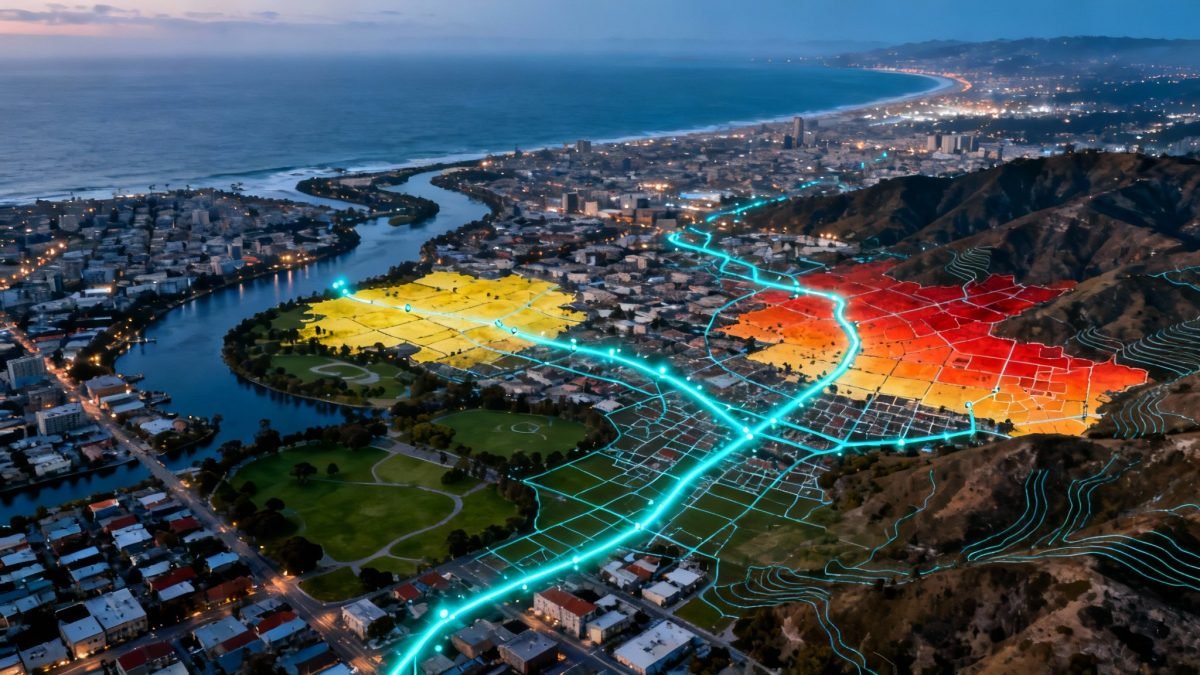Get the week's most popular posts delivered to your inbox.
Our weekly update is free yet priceless and you're less than a minute away from getting the current edition.
In the unlikely event we disappoint, you can unsubscribe with a single click!
Last Updated on November 18, 2025 by teamobn
In today’s data-driven age, geographic information systems (GIS) are the key to making decisions across many fields — from urban planning to conservation. But why and what is GIS data?
In broad terms, GIS data is any information about some set of geographic coordinates on Earth. Such data is used to symbolize natural and constructed features — including rivers, trees, buildings, or transportation systems. When such data is integrated with maps, GIS technology allows experts to symbolize relations among locations, uncover concealed patterns, and make informed decisions.
GIS data is a core asset for all industries, ranging from transport to energy, public health, and agriculture. From efficient road network planning to areas affected by floods, or disease epidemics tracking, GIS converts raw spatial data into meaningful information.
Contents
Types of GIS Data
Fundamentally, GIS data comes in two forms: vector data and raster data.
- Vector Data models features as points, lines, and polygons.
- Example: A city park may be expressed as a polygon, a road as a line, and an isolated tree as a point.
- Raster Data involves a grid of pixels or cells and holds a value within each cell.
- Example: Satellite imagery or elevation maps utilize raster data to map terrain or changes in temperature.
They are utilized collectively to construct sophisticated large-scale spatial analysis. For example, the city’s urban development plan can superimpose vector street networks on raster-based ground maps to witness the influence of geography on metropolitan growth.
Core GIS Data Categories
There are specialized GIS data types other than the raster–vector duality for specific uses:
- Spatial Data – Shape and position of geographical items (e.g., roads, rivers, land parcels).
- Attribute Data – Contains descriptive information regarding spatial objects, i.e., road names, population, or height.
- Imagery Data – Contains satellite and aerial photos that replicate real-scene images.
- Topographic Data – Is a representation of terrain slope and elevation, usually depicted by contour lines or 3D models.
- Environmental Data – Contains variables such as soil condition, plants, rain, and air quality.
- Demographic Data – Concentrates on human activity and population data such as income, age, and education.
Combined, these kinds of data enable policymakers and scientists to model everything from the expansion of metropolises to the effects of global warming — and forecast future patterns based on past events.
How GIS Data Is Applied Across Industry
1. Urban and Regional Planning
Local governments around the world depend on GIS to efficiently run cities. Through spatial information, planners are able to create better transport systems, accommodate land use planning, and find areas that are commercial-friendly or residential zones.
2. Conservation
Scientific data from GIS assists scientists to track deforestation, measure flood risk, and examine patterns of pollution. For instance, satellite images through GIS mapping are capable of revealing vegetation changes over time in a bid to measure the health of an ecosystem.
3. Public Safety and Disaster Management
Emergency responders utilize GIS to generate real-time maps of crises such as hurricanes, earthquakes, or fires. They enable readiness, resource deployment, and evacuation.
4. Health and Epidemiology
GIS is applied in monitoring disease outbreaks and maximizing the availability of healthcare. During the COVID-19 pandemic, observing infection hotspots through mapping became easily the most obvious application of GIS.
5. Transportation and Logistics
Organizations utilize GIS to streamline routes for deliveries, minimize travel time, and enhance fleet operation. GIS enables logistics planners to react in real-time to traffic or weather incidents.
Standard GIS Data Formats
Storage and transmission of the data are equally crucial. Following are the most widely used GIS data formats:
- Shapefiles (.shp): An old format for vector data of points, lines, and polygons.
- GeoJSON: Compact and web-mapping application-compliant.
- KML/KMZ: Generally used to show spatial data inside Google Earth and other map viewers.
- TIFF/GeoTIFF: Raster image files with embedded geographics.
- File Geodatabases (GDB): For advanced multi-layered GIS projects.
- CSV with Coordinates: Uncomplicated tabular data with latitude and longitude columns.
Each of the forms has a compromise between space efficiency in storage, accuracy, and ease of exchange. Web mapping employs GeoJSON, which is becoming increasingly popular because it is supported by online APIs and software.
GIS Data in Action Examples
Applications of GIS data in real practice show how decision-making is based on spatial data:
- Urban Planning: Placing land use, zoning, and public utilities on a map for the purpose of planning infrastructure construction.
- Transportation: Traffic flow modeling to minimize traffic congestion and plan new roads optimally.
- Environmental Science: Floodplain monitoring and erosion hazard prediction using terrain data.
- Public Safety: Aiding in determining dangerous areas for emergency response planning.
- Healthcare: Plan hospital capacities based on regional population statistics.
In many of these use cases, organizations also collaborate with specialized mapping and data analysis professionals to maximize results. For instance, businesses and local governments can enhance their infrastructure planning and environmental monitoring through expert GIS services in Jacksonville, which integrate advanced mapping tools and spatial analytics.
Such services combine local data with advanced visualization technology, helping communities make informed decisions about development, zoning, and environmental protection.
Future Trends in GIS Data
With the changing technology, GIS systems are becoming networked, responsive, and intelligent. The future of GIS information will be shaped by the following trends:
- Artificial Intelligence (AI) and Machine Learning: Predictive analysis and image recognition based on computer vision will enable the identification of land-use change, deforestation, and urban sprawl more effectively.
- Cloud-Based GIS Platforms: Enabling real-time collaboration and distant access to data for world-wide teams.
- 3D GIS and Digital Twins: Developing interactive 3D urban models for simulating urban development plans and infrastructure analysis.
- Internet of Things (IoT): Integrating real-time sensor information—e.g., weather, traffic, and air quality—into GIS platforms to support timely decision-making.
- Open Data Initiatives: Governments are opening spatial data sets to encourage transparency, innovation, and civic participation.
These trends point to GIS as more than a mapping technology but also a critical element of 21st-century smart government and evidence-based policy.
Standardization and Accessibility
The biggest challenge GIS has is standardizing data. With all the sources and formats, it isn’t always easy to make systems communicate with one another. International organizations like the Open Geospatial Consortium (OGC) are creating standards whereby datasets in various systems can be sent into each other with ease.
Why Policymakers and Businesses Care About GIS Data
GIS data is important to governments because it facilitates evidence-based policy making. It is able to pinpoint unserved communities, assess infrastructure performance, and track environmental sustainability.
It is important to businesses because GIS offers location-based marketing, logistics, and site selection data. Retail chains, for instance, use GIS data to decide where to put their stores, taking demographics and traffic into account.
Finally, GIS facilitates smarter decisions with spatial intelligence. It closes the gap between raw data and reality by exposing the “where” that lies behind every question.
Conclusion
It’s not just maps — it’s a smart blend of spatial and descriptive information that informs us about the shape and relation of our world.
From monitoring urban expansion to confronting climate change, GIS data is leading the charge in societies’ and organizations’ decisions about what’s next. With artificial intelligence, Internet of Things, and open data movements already well established, the richness and extent of GIS will only gather more momentum.
In an increasingly location-defined world, GIS remains one of the most useful tools to apply to analyzing, forecasting, and improving the worlds in which we live.
Get the week's most popular posts delivered to your inbox.
Our weekly update is free yet priceless and you're less than a minute away from getting the current edition.
In the unlikely event we disappoint, you can unsubscribe with a single click!






